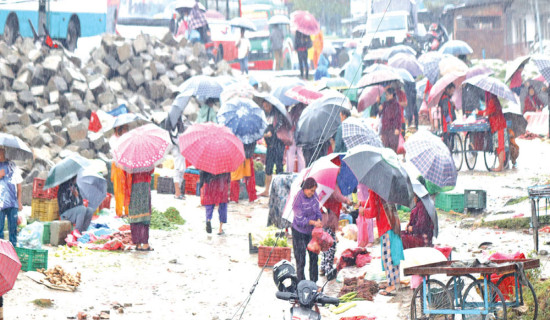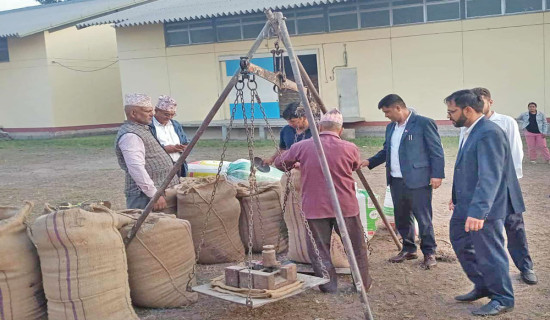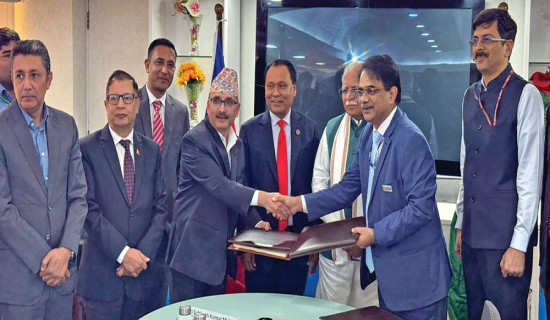- Sunday, 30 November 2025
Upper Tamakoshi, several other hydro projects hampered by rains, floods
Kathmandu, Sept. 29: Several hydropower projects across the country have been affected due to floods in rivers in the wake of heavy rains.
According to the Nepal Electricity Authority, the hydropower projects, including 456 MW Upper Tamakoshi Hydropower Project have been completely shut down due to floods caused by heavy rains. Five people have gone missing at the Upper Tamakoshi after a landslide damaged the building housing the head works control room of the project.
Chandan Kumar Ghosh, spokesperson of the Authority, said that power production of around 1,200 MW from about a dozen hydropower projects, including Upper Tamakoshi, has been temporarily shut down due to the floods caused by heavy rains.
He said that the Upper Tamakoshi HEP was completely shut down while many other projects were partially closed.
Power generation of hydropower projects, including 50 MW Solu Dudhkosi, 47 MW Likhu-1, 29 MW Likhu-2, 38 MW Middle Tamor and 7 MW Modi Hydropower is taking place partially.
Similarly, the hydropower projects operating at Kabeli corridor has been affected by the rains and floods.
He said that the landslides caused by incessant rains have damaged the structure (headworks) of the dam area of the 456 MW Upper Tamakoshi Hydropower Project located in Bigu Rural Municipality-1 Lamabagar of Dolakha.
According to the NEA, power generation of the hydropower project has been stopped from 7 PM on Friday after the water flow in Upper Tamakoshi was high.
All the gates of the dam have been opened.
A little below the dam site on the right side, the control room, the descender pond and the canal (culvert) that carries water from the dam to the descender have been damaged.
It is estimated that the control room, descender and culvert have been heavily damaged due to the landslide that fell from above.
Chief Executive Officer (CEO) of Upper Tamakoshi Hydropower Limited Mohan Gautam said that no one could reach there due to floods in the rivers on the entrance way from Gongar to the dam, where the power plant is located.
Gautam said that looking at the nature of the landslide, it is estimated that the control room, descender and culvert and other structures have been damaged.
Due to the landslide, a large amount of stones and mud have piled up in the reservoir area, he said.
The condition of five people, including two employees of the company working in the control building, two soldiers of Nepal Army and one security guard, is unknown, the company said.
The company has been coordinating with the District Administration Office Dolakha and urged the security agencies to rescue them by taking all measures including helicopters.
The design discharge (flow of water) of Tamakoshi project is 66 cusecs. At present, there are 461 cusecs in the downstream of Tamakoshi river dam.
As per the power purchase agreement signed with the Nepal Electricity Authority, the power plant should be shut down as soon as the water flow in the river reaches 250 cusecs.
After 4 pm on Friday, the water flow exceeded 250 cusecs and the water flow continued to increase, so the electricity generation was completely stopped from 7 PM, said Gautam.
Kulekhani operating in full capacity Meanwhile, due to incessant rains, the reservoir of the Kulekhani Hydropower Station in Makwanpur is full.
The two gates in the dam have been partially opened since 5.45 AM on Saturday morning after the water level in the reservoir was high and the water started flowing out of the spillway, said the NEA.
As the water level started to rise, the 60 megawatt power plant has been running continuously at full capacity since Friday.
Even when the power plant is running at full capacity, the water storage capacity of the reservoir is full due to incessant rains in the watershed area. The water level in the reservoir has reached 1530.93 metres above sea level.
According to chief of Kulekhani Hydropower Station Taradatta Bhatta, the dam gates were partially opened after the water level reached 1530.35 metres.
Bhatta said that there is a situation where both the gates will have to be opened completely as there is continuous rain with strong winds in the watershed area of Kulekhani.
As the gates of the dam have been opened, the flow of the Bagmati River in the lower coastal area of the reservoir will increase, so the centre has requested the local residents of that area to stay safe and on high alert.
Meanwhile, it has been reported that the powerhouse of 22 MW Mandu HEP was completely submerged with the increased flood level in the Bagmati River and opening of the Kulekhani Dam.
Likewise, power house of 22.1 MW Lower Hewakhola HEP in Panchthar district is also submerged. The bridge of the Hewa River, which was washed away by the floods last year, has also been washed away this year.
Power supply disrupts in many places, including Kathmandu Valley Meanwhile, electricity supply in many places has been affected due to continuous rains.
The supply has been affected as the rain has damaged the infrastructure of the electricity transmission and distribution system, according to the NEA.
According to NEA spokesperson Ghosh, electricity supply has been affected in half the areas of Kathmandu Valley.
He said that the demand for electricity in Kathmandu Valley is about 400 MW in normal conditions, but it was only about 200 MW on Saturday.
He said that the NEA has currently been importing around 200 MW electricity to meet the demand.
The power supplies in Godawari, Imadol, Lubhu, Chyasal areas of Lalitpur have been affected.
The feeders supplying electricity to Khopasi, Nalinchowk and Bode water supply from Bhaktapur substation are closed.
Similarly, Khumaltar, Imadol, Satdobato, Godawari, Hattiwan, Chapagaon, Khokana, Chakrapath, Harisiddhi, Radio Nepal and Lubhu feeders which are supplied with electricity from Patan substation are closed.
The Gairidhara feeder supplying electricity from Lanchaur substation is closed, said the NEA.
The electricity supplies in Kirtipur, Bagmati, Tahachal, Sundhara, Kalimati, Chakrapath and Chamati have been affected.
The electricity supply has been disrupted in Handigaun, which is being supplied with electricity from the new Chabhil substation, and Kalanki, Balambu ropeway feeders, which are being supplied electricity from Kalopul and Syuchatar substations, have been affected.
Ghosh said that the team is working to restore the power supply as soon as possible. However, he said that many places are submerged and the river level has risen, making it difficult to resume the line.











-original-thumb.jpg)





